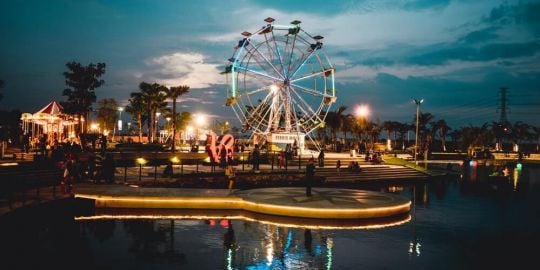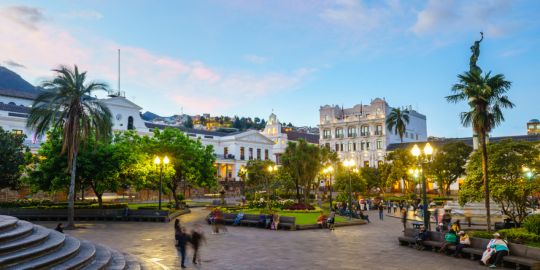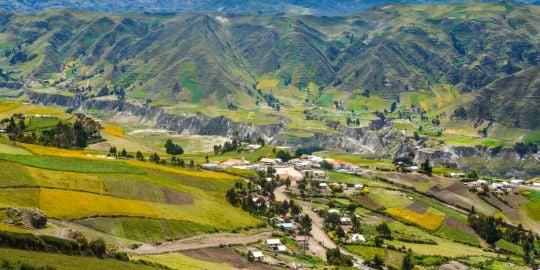eltelegrafo.com.ec reported that a state of emergency has been declared declared today in 17 provinces of the country because of the presence of El Niño. President Correa issued the emergency decree to last last 60 days. According to Ecuador's Constitution, the state of emergency allows the President to suspend or limit freedom of movement, freedom of association and assembly, and freedom of information. Border crossings may be instituted and the Armed Forces and National Police may be used as necessary. The only provinces not included in the decree are Tungurahua, Sucumbíos, Orellana, Napo, Pastaza, Morona Santiago and Zamora Chinchipe. Tthe Secretariat for Risk Management declared a yellow alert in 17 provinces because of El Niño last week. http://latinamericacurrentevents.com/ec … ino/34912/
Ecuador: State of Emergency Declared because of presence of El Niño
Hi, After an internet search, I still cannot find specific information on the exact areas that are affected by the State of Emergency. We are preparing to leave the US to come to Ecuador, starting in Quito with a trip planned to Galapagos in early December 2015. Does anyone in Ecuador have more information on how Galapagos is being affected right now and what is expected into early December?
I saw 1 canceled flight from Quito to Galapagos, but the rest see to have departed on are still on the boards.
Can you give me links to find specific info on the State of Emergency?
Are we making a huge mistake by making this trip?
Thank you.
wendy-adventurousretirement wrote:We are preparing to leave the US to come to Ecuador, starting in Quito with a trip planned to Galapagos in early December 2015. Does anyone in Ecuador have more information on how Galapagos is being affected right now and what is expected into early December?
For a couple of months, we've been warning folks away from the Galápagos and coastal Ecuador for December of this year and the first part of 2016, as this has been predicted to be the peak season of El Niño.
Personally, I would not risk exposing myself or family members to the possibility of massive wave action, flooding and their effects in the Galápagos in December-February. In your position, I would immediately call the airline/travel agent/booking website you are using .. and find out if you can cancel the Galápagos portion of your EC visit without substantial penalty under the circumstances.
The Galápagos Islands are likely to be the first place in Ecuadorian territory to be struck although trying to time with any accuracy this huge complex of weather systems is about as likely as timing the New York Stock Exchange.
Presuming that you make it to Ecuador, better to visit Quito or Cuenca or Loja/Vilcabamba than anywhere in or around the Pacific coastal areas.
cccmedia in Quito
wendy-adventurousretirement wrote:I still cannot find specific information on the exact areas that are affected by the State of Emergency....
I saw 1 canceled flight from Quito to Galapagos, but the rest seem to have departed on are still on the boards.
Crowdpub's account of the State of Emergency in Report #1 above is accurate.
The area covered by El Presidente's emergency declaration is comprised of 17 provinces in Ecuador -- everywhere in the country except the specific exceptions listed in Report #1.
----------
The fact that many flights are still leaving for the Galápagos Islands now in mid-November is absolutely not a predictor of how bad things might be weeks from now in December when your visit there is planned.
Why risk going to the Galápagos at what may be the worst possible time since the 90's....
cccmedia in Quito
Thanks. Mostly because it is paid for and it looks like our insurance only pays us back if the trip is delayed or canceled due to a natural disaster or severe weather; the threat of severe weather doesn't count. I was thinking that a State of Emergency might count. We will be in Quito in December.
I've been following this thread out of curiosity as I imagine many others are. It doesn't match common sense to go to the Galapagos Islands and put yourself in harm's way when the forecast is this ominous, regardless of the ticket insurance, The consequences could be terminal. Of course you may be foolhardy and go anyway, and get lucky. The fact that you are considering the proposition tells a story. So do you (both) feel lucky?
Expat.com's Home Office has elevated the status of this State of Emergency thread, and this thread has now replaced in prominence the still-active thread titled El Niño 2015 on the Ecuador Forum Welcome Page.
The Home Office agreed to make this new thread the primary one for El Niño going forward for two reasons....
1. It introduced the new information about the State of Emergency.
2. The title of the El Niño 2015 thread makes it a 'dated' thread. 2015 will be running out of time in a few weeks, but this season's El Niño may not peak until the early months of 2016.
The El Niño 2015 thread contains posters' warnings about El Niño at the coast dating back to September 2015 ... warnings about the Galálpagos Islands' vulnerability ... items to put into a go-bag in advance of major trouble ... and commentary about how to stay safe.
The following is the link to the El Niño 2015 thread. Please post any new comments about El Niño on this State of Emergency thread starting now for enhanced exposure ....
https://www.expat.com/forum/viewtopic.php?id=517435
cccmedia in Quito
wendy-adventurousretirement wrote:Can you give me links to find specific info on the State of Emergency?
Ecuador Emergency Links.
With two volcanoes becoming active and now El Niño, 2015 has been a wake-up call to the potential for natural disasters in La República.
The activity at the enormous Cotopaxi volcano led to a preparedness meeting at the U.S. Embassy in Quito a few months ago, and our Ecuador forum collected contact information links at the meeting.
Here are two of those EC government links, which are both in Spanish. The first site is mostly Cotopaxi specific at the moment, but may be updated at any time. The second one now offers an online button for Fenómeno El Niño (the El Niño Phenomenon)....
www.seguridad.gob.ecwww.gestionderiesgos.gob.ec
The English-language U.S. Embassy link in Ecuador is ecuador.usembassy.gov ... This site has options for natural disaster alerts and warnings. It does not appear to have El Niño information yet .. but does have a link to what the U.S. government can and cannot do in an emergency. Also, there is information about the Embassy's STEP notification program.
Here are Spanish-language links we were given for the U.S. Embassy that may be useful in an emergency....
https://twitter.com/usembassy_quitowww.facebook.com/USEmbassyQuito
Here is another link with emergency information....
www.ecu911.gob.ec
More links and contact information are available in Reports 57 and 58 of the Cotopaxi volcano thread.
Reports 41 through 47 at the Cotopaxi thread contain information in English that may be valuable in preparing for / dealing with El Niño as well as volcanoes.
Here is the link to the Cotopaxi thread....
https://www.expat.com/forum/viewtopic.php?id=492658
-- cccmedia in Quito
Celebrity Cruise Lines has made no changes in their cruises scheduled in the Galapagos islands, sailing outrageously priced 7 day cruise with all inside cabins full. Currently the cheapest cabins, outside, are over $4,000 per person. The ship is located in the islands and only sails around the islands, the people must fly in and fly out at additional costs .
Thank you!
Facts About El Niño in Ecuador.
The El Niño event of 1997-98 cost Ecuador 14.5% of its Gross Domestic Product.
El Niño causes a weakening of the trade winds, causing heat to accumulate. This changes global weather, causing flooding in some areas and drought in others.
Ecuador and Peru are the two countries most directly affected by El Niño. "If the predictions are correct, the months ahead could cause debilitating floods, outbreaks of mosquito-borne illnesses and catastrophic crop and infrastructure damage."
Source: "Ecuador Braces for El Niño," on the environmental-issues website www.triplepundit.com ... The article contains multiple links to other sites providing information on the El Niño phenomenon.
cccmedia in Quito
Preparedness Issues.
Says a former co-ordinator for Risk Management in coastal Manabí province, Roque Mendoza: "I do not think we are ready for El Niño." He says "lack of training and people not knowing what to do in an emergency is what causes tragedies to be magnified."
Massive and rapid de-forestation has occurred in Ecuador's coastal forests since the 1950's. 70 percent of the coastal mangroves have been removed by commercial shrimp interests. This de-forestation compounds El Niño effects, as lack of vegetation results in mudslides -- resulting in many fatalities.
"Disasters are not only caused by nature," said Mendoza, "but also by human hands and lack of prevention."
Source: same El Niño article at www.triplepundit.com
cccmedia in Quito
How an Ecuadorian Fishing Village is Dealing With El Niño.
The TriplePundit reporter, Sarah Lazanova, visited the coastal town of Puerto López.
She found that residents there are concerned that the major beachfront road is now at higher elevation than some of the surrounding homes, magnifying the threat of property damage from flooding.
In Puerto López, she writes, "a major beachfront construction project is building bridges over rivers and burying beachfront power lines under a new road, which could help prepare the town for strong storms.... There is a sense among many residents that this project does not address more urgent needs, such as waste-water treatment and access to potable water."
A Puerto López hotel owner who spoke with the reporter has constructed a flood wall behind his property since El Niño flooded the area in 2002. She saw another homeowner who was adding fill to raise the elevation of his property.
However, she reported that she saw few other signs that anyone else in the infrastructure-challenged town is taking precautions so far during the current El Niño season.
cccmedia in Quito
Disease.
The increased rain during El Niño could cause a spike in mosquito-borne illnesses, including malaria, chikungunya, and dengue.
Illness could be produced by compromised infrastructure and sanitation .. combined with interruptions of health services and lack of access to potable water.
Practices that promote the breeding of mosquitos are common among vulnerable coastal populations despite past public campaigns to promote health practices that could reduce the mosquito problems.
Source: "Ecuador Braces For El Niño," www.triplepundit.com
cccmedia in Quito
Thank you for the info. Martha
Update of December 12, 2015, on El Niño.
Ecuador's government now says the current El Niño is strengthening and water readings in the ocean show that it is the strongest El Niño on record.
This is a reversal of the government's position of late November, when Presidente Correa stated that this El Niño was of moderate strength.
The government now says there was a weakening but it was a short-term anomaly.
The U.S. oceanic and atmospheric agency, NOAA, is reporting high ocean-water temperatures and is warning about the growing strength of El Niño.
The State of Emergency remains in effect in 17 provinces of Ecuador.
The EC government is rushing to complete several flood-control projects in areas west of the Andes.
Source: www.cuencahighlife.com
-- cccmedia in Quito
While we have heard this and were warned not to go to Galapagos, we have just returned to Quito and found nothing unusual in Galapagos, except perhaps the water was a bit warmer. The weather and seas were fine, and we saw plenty of animals. Up to now there has not been any negative affects. Of course, anything can happen. I am glad that we went on the trip despite the warnings.
wendy-adventurousretirement wrote:we have just returned to Quito and found nothing unusual in Galapagos, except perhaps the water was a bit warmer. The weather and seas were fine....Up to now there has not been any negative affects.... I am glad that we went on the trip despite the warnings.
The main El Niño impacts will be in December-March, so we are "just at the very beginning" of finding out what this El Niño will bring.
Source: December Update on El Niño from the National Oceanic
and Atmospheric Administration issued on or about
December 10, 2015, at climate.gov
-- cccmedia in Quito
El Niño kicked into a higher gear this week in Ecuador as high tides flooded coastal areas from Esmeraldas to Salinas -- a distance of 237 miles or 381 kilometers.
Tides up to 10 feet higher than usual (3 meters) flooded several coastal communities on Sunday and Monday (January 10-11, 2016).
Several homes were destroyed in Esmeraldas Province and there was property damage along much of the EC coast.
Streets and sidewalks were flooded and sometimes undermined. In Salinas, seawater overwashed the malecon. Authorities reported there was water damage in some buildings.
In Jama, strong waves collapsed part of a seawall and destroyed pavement along the malecon.
Retired geology professor Jorge Gonzalez, who lives near Salinas, says some of the condos along the Salinas malecon will be destroyed within a generation.
"The ocean has moved in 100 meters during my lifetime and it will only take a few more meters for it to begin taking down the buildings."
Ecuador's meteorological office said the tides were expected to subside on Tuesday and Wednesday but will return intermittently as El Niño affects the coastline.
Source: www.cuencahighlife.com
Two days of torrential rains (January 11-12) this week caused dozens of Cuenca homes to be flooded with up to two feet of water.
The Machángara River in Cuenca overflowed its banks both days, depositing up to a foot of mud on nearby streets. Car drivers and two city buses were stranded.
Source: www.cuencahighlife.com
El Niño in the Big G and along the Coast....
Ecuador's largest city, Guayaquil, was hit by torrential rains at midweek -- stranding buses and motorists in water up to one meter (39 inches) high.
The Guayaquil rains and flooding are an "example of what we can expect as El Niño begins to have more effect," said a government meteorology official.
In Chone, Manabí Province, that city's sewer system collapsed due to flooding and mudslides. This has been causing a shortage of drinking water. Damage to homes in Chone is also reported.
Esmeraldas in northwestern Ecuador got smacked again with damage to homes due to rain and flooding.
Rains will be more frequent and more intense in coming weeks, according to the meteorology official in Guayaquil.
Source: www.cuencahighlife.com
-- cccmedia in Quito
January 27, 2016: Guayaquil, Manta and Esmeraldas were flooded this week by heavy rains and high tides of El Niño.
It's the third time the Big G has been flooded in a week.
Source: www.cuencahighlife.com
-- cccmedia in Quito









